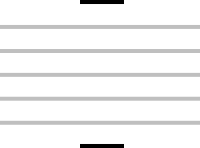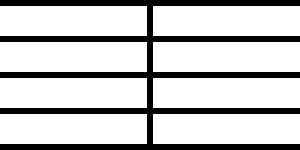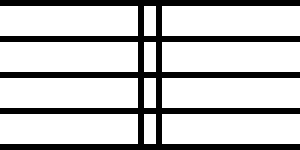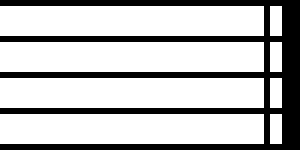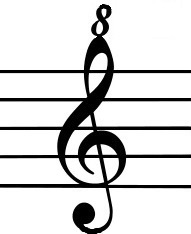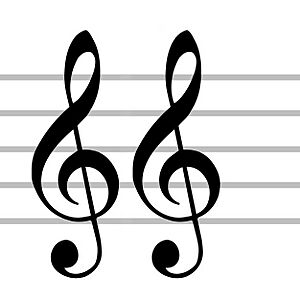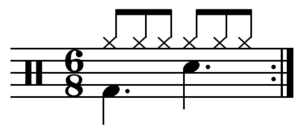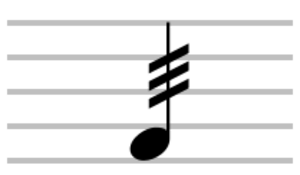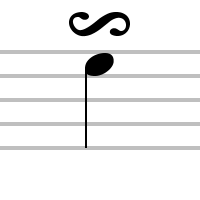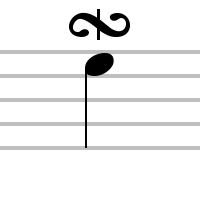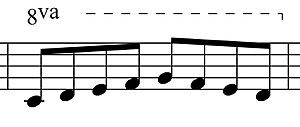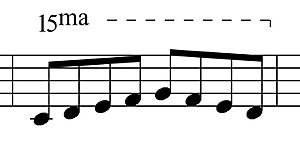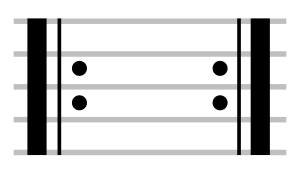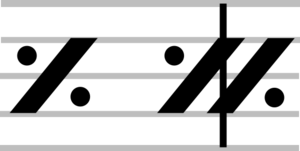List of musical symbols facts for kids
Musical symbols are special marks and symbols used in musical notation. They tell musicians how to play a piece of music. These symbols give information about many things, like the pitch (how high or low a note is), duration (how long a note lasts), dynamics (how loud or soft to play), or how to play notes clearly (called articulation).
They also show the tempo (speed), metre (the beat), and form (if parts are repeated). Some symbols even explain specific ways to play, like which fingers or pedals to use, or if a string instrument should be bowed or plucked.
Contents
- Lines on the Music Staff
- Clefs: Showing Pitch Ranges
- Breaks in Music
- Accidentals and Key Signatures
- Time Signatures
- How Notes Relate to Each Other
- Dynamics: How Loud or Soft
- Articulation Marks: How to Play Notes
- Ornaments: Decorating Notes
- Octave Signs: Playing Higher or Lower
- Repetition and Endings
- Instrument-Specific Notation
- Images for kids
- See also
Lines on the Music Staff
Musical lines help us understand how music is written.
| Staff
The staff (or stave) has five lines. It shows the pitch of notes. Each line or space stands for a note with a letter name: A, B, C, D, E, F, G. As you go up the staff, the notes go up in pitch and follow the alphabet. A clef is usually added to show which specific note goes on which line. |
|
| Ledger lines
These are extra lines that appear above or below the staff. They are used when notes are too high or too low to fit on the main five lines. You can use one or many ledger lines. |
|
| Bar line
Bar lines divide music into measures (or "bars"). The time signature tells you how many beats are in each measure. Sometimes, bar lines go through several staffs to group instruments together, like in a grand staff for piano. |
|
| Double bar line
These lines show a change in the music. This could be a new section, a new key, or a new time signature. |
|
| Bold double bar line
This thick double bar line means the end of a piece of music or a major part of it. |
|
| Dotted bar line
Dotted bar lines help break up long or complex measures into smaller, easier-to-read parts. |
|
| Brace
A brace connects two or more lines of music that are played at the same time, usually by one player. This is common for instruments like the piano, harp, or organ that use a grand staff. |
|
| Bracket
A bracket also connects two or more lines of music played at the same time. It usually links staffs for different instruments, like a flute and a clarinet. The brace is for one instrument with multiple parts, while the bracket is for different instruments. |
Clefs: Showing Pitch Ranges
A clef is a symbol at the start of the staff. It tells you which specific note goes on a certain line. This helps define the range of pitches for the music on that staff.
| G clef (Treble clef)
The G clef's spiral shows where the G note above middle C is located. When it's on the second line of the staff, it's called the treble clef. This is the most common clef in modern music. |
|
| Alto clef Tenor clef |
C clef (Alto and Tenor clefs)
The middle of a C clef points to the line that represents middle C. If it's on the third line, it's the alto clef, often used for the viola. If it's on the fourth line, it's the tenor clef. This clef is used for instruments like the bassoon or cello when their notes get very high, to avoid too many ledger lines. |
| F clef (Bass clef)
An F clef places the F note below middle C on the line between its two dots. When this F is on the fourth line, it's called the bass clef. This clef is almost as common as the treble clef. |
|
| Octave clef
These clefs change the pitch of notes by one or two octaves. An "8" below the clef means the notes sound an octave lower. An "8" above means they sound an octave higher. A "15" means two octaves. The treble clef with an "8" below is common for guitar or tenor voices. |
|
| On a 5-line staff On a single-line staff |
Neutral clef
This clef is for instruments that don't have a specific pitch, like most percussion instruments. The lines and spaces don't show pitch, but rather different instruments in a drum set. It can also be on a single line for one percussion instrument. |
| Tablature
This is not a true clef either. It's used for some string instruments, like the guitar. The lines represent the strings of the instrument. Numbers on the lines show which fret to press. |
Breaks in Music
These symbols tell you to pause or create a small gap in the music.
| Breath mark
This symbol tells a musician to take a breath (for singers or wind instruments) or make a small pause. It doesn't change the speed of the music. For bowed instruments, it means to lift the bow. |
|
| Caesura
A caesura means a short, silent pause where the rhythm stops for a moment. |
Accidentals and Key Signatures
These symbols change the pitch of notes or set the main key of a piece.
Common Accidentals
Accidentals change the pitch of notes for a short time, usually within one measure.
| Flat
The flat symbol lowers a note's pitch by one semitone (the smallest step in Western music). |
|
| Sharp
The sharp symbol raises a note's pitch by one semitone. |
|
| Natural
A natural symbol cancels a sharp or flat. It makes the note return to its original pitch. |
|
| Double flat
A double flat lowers a note's pitch by two semitones (a whole step). |
|
| Double sharp
A double sharp raises a note's pitch by two semitones (a whole step). |
Key Signatures
Key signatures are found at the beginning of a piece of music. They show which notes should always be played as sharps or flats. This saves the composer from writing an accidental next to every single note. A key signature tells you the main key of the music.
Flat key signatures
Sharp key signatures
Time Signatures
Time signatures tell you how many beats are in each measure and what kind of note gets one beat.
| Simple time signatures
This example shows 3 |
|
| Compound time signatures
In compound time, beats are grouped in a special way. This example shows 6 |
|
| Common time
This symbol is a shortcut for 4 |
|
| Alla breve or cut time
This symbol is a shortcut for 2 |
|
| Metronome mark
This tells you the exact speed (tempo) of the music. For example, "120 quarter notes per minute" means you should play 120 quarter notes in one minute. |
How Notes Relate to Each Other
These symbols show how notes connect or group together.
| Tie
A tie connects two notes of the same pitch. You play them as one longer note, adding their durations together. |
|
|
|
Slur
A slur connects two or more notes of different pitches. It means to play the notes smoothly, without stopping the sound between them. For singers, it means singing notes on one syllable. A tie only connects two notes of the same pitch, but a slur can connect many notes of any pitch. |
| Glissando or Portamento
This means to slide smoothly from one note to the next, playing all the notes in between. Some instruments, like a trombone, can do this continuously. Others, like a piano, play the notes very quickly to sound like a slide. |
|
| Tuplet
A tuplet is a group of notes that fit into a space where a different number of notes would normally go. A common example is a triplet, where three notes are played in the time of two. |
|
| Chord
A chord is when several notes are played at the same time. A two-note chord is a dyad. A three-note chord built with thirds is a triad. |
|
| Arpeggiated chord
This is a chord where the notes are played one after another very quickly, usually going up. Each note is held as the next one is played. It's also called a broken chord. |
Dynamics: How Loud or Soft
Dynamics tell you how loud or soft to play the music.
| Pianississimo
Extremely soft. |
|
| Pianissimo
Very soft. |
|
| Piano
Soft. |
|
| Mezzo piano
Moderately soft. |
|
| Mezzo forte
Moderately loud. If no other dynamic is written, this is usually the assumed volume. |
|
| Forte
Loud. |
|
| Fortissimo
Very loud. |
|
| Fortississimo
Extremely loud. |
|
| Sforzando
This means to play a single note or chord with a sudden, strong accent. |
|
| Fortepiano
Play the note loudly at first, then immediately become soft. |
|
| Crescendo
A gradual increase in volume. It can be extended to show a long increase in loudness. |
|
| Diminuendo
Also decrescendo. A gradual decrease in volume. |
|
| Niente
Means "nothing". Used to show starting from silence (crescendo from niente) or fading to silence (diminuendo to niente). |
The exact meaning of dynamics can change depending on the performer or conductor.
Articulation Marks: How to Play Notes
Articulations tell you how to play individual notes, like their length, volume, and attack style. These marks can be above or below a note.
| Staccato
Play the note shorter than its written value, leaving a short silence after it. |
|
| Staccatissimo
Play the note even shorter than staccato. For string instruments, it can mean the bow bounces lightly. |
|
| Tenuto
Hold the note for its full value, or slightly longer. It can also mean to give the note a bit more emphasis. |
|
| Fermata or Pause
Hold a note, chord, or rest longer than its written value. The performer or conductor decides how long to hold it. |
|
| Accent
Play the note louder or with a stronger attack than the notes around it. |
|
| Marcato
Play the note even louder or more forcefully than a regular accent. |
Ornaments: Decorating Notes
Ornaments change the pitch pattern of individual notes, adding decoration.
|
|
Tremolo
A very fast repetition of a single note. If it's between two notes, you play them in rapid alternation. The number of slashes shows how fast to repeat. For percussion, tremolos can mean rolls or drags. |
| Trill
A rapid back-and-forth playing between the written note and the note just above it. A wavy line after it means a longer trill. |
|
| Upper mordent
Quickly play the main note, then the note above it, then return to the main note. |
|
| Lower mordent (inverted)
Quickly play the main note, then the note below it, then return to the main note. |
|
| Gruppetto or Turn
When above a note, it means to play the note above, then the main note, then the note below, then back to the main note. If it's to the right of the note, you play the main note first. An inverted turn reverses the order of the notes above and below. |
|
| Appoggiatura
A small grace note that takes up part of the main note's time. The main note starts on the pitch of the grace note. |
|
| Acciaccatura
A very short grace note that is played quickly, almost at the same time as the main note. The main note gets almost all of its written duration. In percussion, this can mean a "flam". |
Octave Signs: Playing Higher or Lower
These signs tell you to play notes one or two octaves higher or lower than written.
| Ottava alta
8va above the staff means play the passage one octave higher. |
|
| Ottava bassa
8vb below the staff means play the passage one octave lower. |
|
| Quindicesima alta
15ma above the staff means play the passage two octaves higher. |
|
| Quindicesima bassa
15mb below the staff means play the passage two octaves lower. |
Repetition and Endings
These symbols help composers avoid writing out repeated sections of music.
| Repeat signs
These marks enclose a section of music that should be played more than once. If there's no left repeat sign, you repeat from the very beginning of the piece. |
|
| Simile marks
These mean to repeat the previous group of beats or measures. The first example usually means repeat the last measure, and the second means repeat the last two measures. |
|
| Volta brackets (1st and 2nd endings)
If a repeated section has different endings, these brackets show which ending to play each time. The "1st ending" is played the first time, and the "2nd ending" is played the second time. |
|
| Da capo
Means "from the top". It tells you to go back and repeat the music from the very beginning. It's often followed by al fine (repeat to the word fine and stop) or al coda (repeat to the coda sign, then jump to the coda). |
|
| Dal segno
Means "from the sign". It tells you to repeat the music starting from the nearest segno symbol. Like da capo, it's followed by al fine or al coda. |
|
| Segno
This is the sign used with dal segno. |
|
| Coda sign
This symbol marks a forward jump in the music to the ending section, also called the coda. You only jump here after seeing a D.S. al coda or D.C. al coda instruction. |
|
| Fine
This word means "end". It marks the very end of a piece or movement, especially after a repeat instruction like D.C. al fine. |
Instrument-Specific Notation
Some symbols are used for particular instruments.
Bowed String Instruments
| Left-hand pizzicato
On string instruments, this means to pluck the string with the left hand (the hand that usually presses the strings down). |
|
| Snap pizzicato
On string instruments, this means to pluck the string so hard that it snaps against the instrument's body. It's also called a Bartók pizzicato. |
|
| Natural harmonic
On string instruments, this means to play a natural harmonic, which creates a clear, ringing sound. |
|
| Up bow
On a bowed string instrument, this means to draw the bow upward. On a guitar, it means an upstroke with the pick. |
|
| Down bow
On a bowed string instrument, this means to draw the bow downward. On a guitar, it means a downstroke with the pick. |
|
| Con sordino ("with mute")
This symbol tells the musician to use a mute on their instrument. |
|
| Senza sordino ("without mute")
This symbol tells the musician to remove the mute. It's usually seen after a muted section. |
Guitar Fingerpicking
Guitar music sometimes uses letters to show which finger to use for plucking strings. These come from Spanish or Latin names for fingers.
| Symbol | English |
|---|---|
| p | thumb |
| i | index |
| m | middle |
| a | ring |
Piano Pedal Marks
These marks are for instruments with sustain pedals, like the piano.
| Engage pedal
Tells the player to press the sustain pedal down. |
|
| Release pedal
Tells the player to lift the sustain pedal up. |
|
| Variable pedal mark
This shows exactly how to use the sustain pedal. The long line means to keep the pedal down. The inverted "V" (Λ) means to quickly lift and press the pedal again. |
|
| U.C. | una corda or U.C.
Tells the player to press the soft pedal down. |
| T.C. | tre corde or T.C.
Tells the player to lift the soft pedal up. |
Piano Hand and Finger Notation
| Left hand | Right hand | |
|---|---|---|
| English | l.h. or left hand | R.H. or right hand |
| 1, 2, 3, 4, 5 | Finger identifications:
|
Other Stringed Instruments (not harp)
| 0, 1, 2, 3, 4 | Finger identifications:
|
Four-Mallet Percussion
| 1, 2, 3, 4 | Mallet identifications:
|
Six-Mallet Percussion
| 1, 2, 3, 4, 5, 6 | Mallet identifications:
|
Images for kids
See also
 In Spanish: Signos musicales para niños
In Spanish: Signos musicales para niños
- Singing
- Musical instruments
- Music theory
- Glossary of musical terminology



